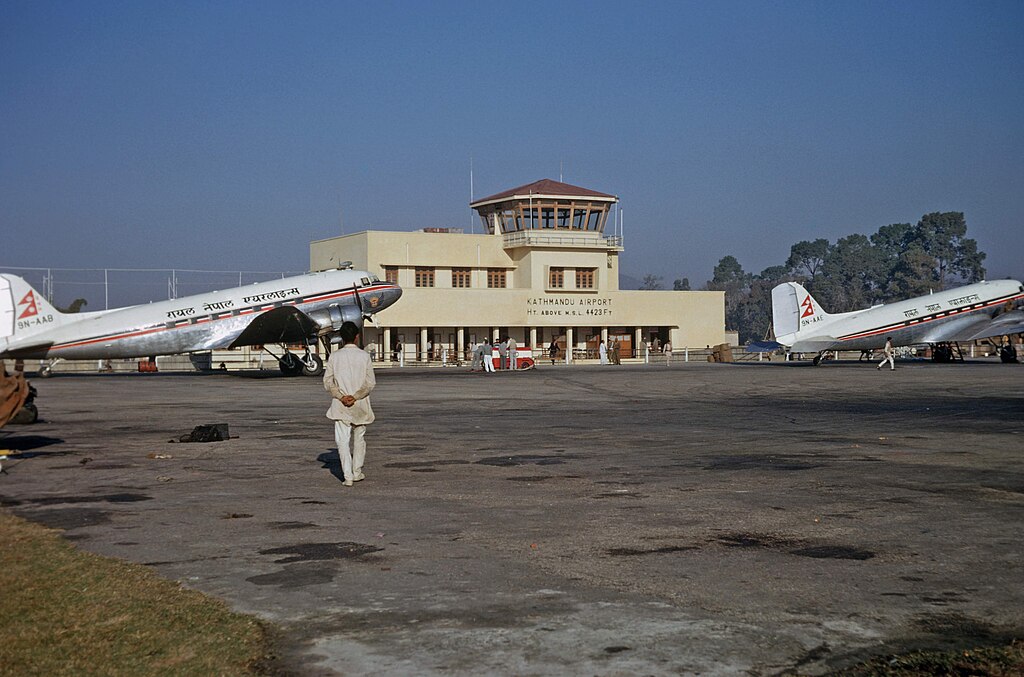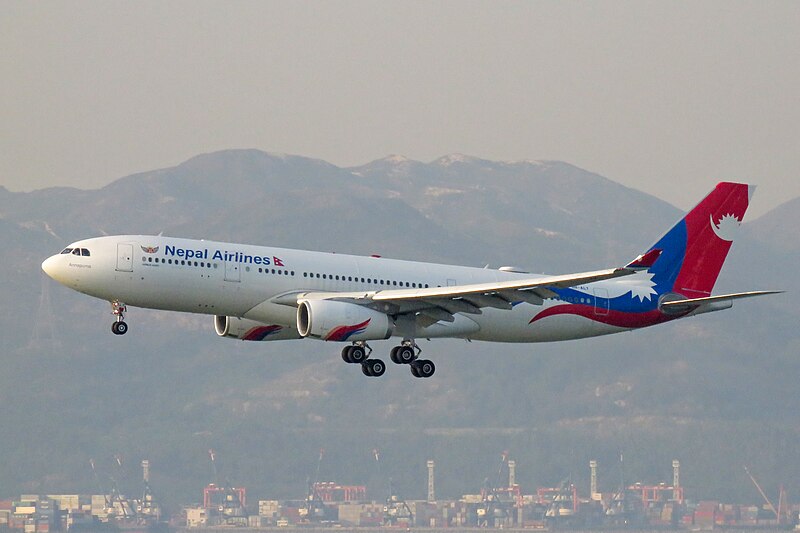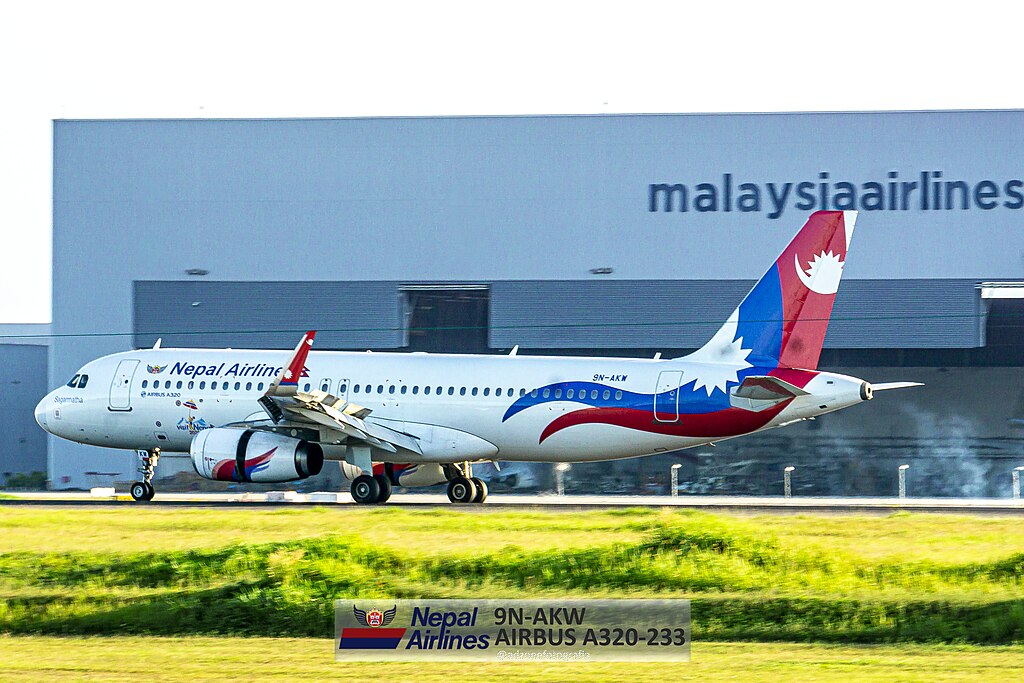Nepal Airlines used to operate to cities like London, Frankfurt, and Paris, which house not only the busiest international airports in the world but also the busiest global airports. It can well be said that Nepal Airlines was the first operator to the most dangerous airport in the world– Lukla Airport.
But in 2019, the flag carrier of Nepal was pushed into bankruptcy. The airline has also been involved in the Airbus A3330 widebody scandal- the largest airline scam in Nepal. For a carrier as glorious as this, the fact that it has been banned into operating in Europe is quite a shame. It has often been said that the history of Nepal Airlines Corporation has been marred with various scandals.
At a point in history, Nepal Airlines was the biggest employer in the nation, alongside being the biggest foreign currency generator in Nepal. Let’s take a look into how politics has brought this carrier almost to its knees.
History of Nepal Airlines

Photo: Don Christie| Wikimedia Commons
Nepal Airlines began its journey in 1958 as Royal Nepal Airlines Corporation (RNAC), starting with a Douglas DC-3 Dakota. Currently, the airline has a total of 12 aircraft, but only 6 are in operation. Here’s a look at the types of aircraft used by Nepal Airlines.
Historic fleet and current fleet
| Historic fleet | No of aircraft | current fleet | No of aircraft |
| Boeing 757-200/Boeing 757-200M | 1/1 | Airbus A320-200 | 4 |
| De Havilland Canada DHC-6 Twin Otter | 4 | De Havilland Canada DHC-6 Twin Otter | 2 |
| Total | 6 | 6 |
In its first year of operation, the airline had only one aircraft, which it used to operate to various locations.
- Pokhara, which is now home to Pokhara International Airport, which is also considered to be China’s debt trap.
- Biratnagar, which is home to a major airport of Nepal- Biratnagar Airport.
- Bhairahawa, which is home to Gautam Budhha International Airport.
- Simara
After a year, RNAC became international, operating in Patna, Delhi, and Kolkata. It was thriving, adding new planes and routes. From 1970 to 1980, it was a golden period for the airline, as it expanded routes to European cities. In 1972, they added a Boeing 727 jetliner (the first jetliner of Nepal) and brought in experts from France to strengthen management by hiring top-level personnel.
At that time, more than 2,200 employees worked for the airline, generating significant foreign currency revenue. The fleet included 19 aircraft, three of which were Boeing 727s and Boeing 757s. At that time, only two airlines operated Boeing 757s (Singapore Airlines and Royal Brunei). Eventually, they acquired more Boeing 757s and operated in over 40 locations.
Here’s a table highlighting the timeline of Nepal Airlines during this time.
| January 1960 | Starts flights to Patna, India (connecting to Delhi and Calcutta) |
| 1966 | Started aerial sightseeing tours
After the acquisition of Fokker F-27 Friendship, |
| 1977 | Using leased Lufthansa jets, it began services to Frankfurt |
| 1980s | Flew to 38 domestic and 10 international destinations |
Multiparty democracy in Nepal marked the start of fall from grace
In 1990, a revolution and mass movement led to the overthrow of the king and the establishment of democracy, with political parties taking control of the country. Politics soon infiltrated the airline industry, resulting in the appointment of individuals close to ministers to top management positions, rather than appointments based on meritocracy. While it can’t be debated that the before the overthrow of the king, people close to monarchy could hold positions of power, some critics claim that absence of meritocracy was more pronounced after multi-party democracy kicked in.
Before August 1992, no private airlines operated in Nepal, and Nepal Airlines held the entire market share. However, in 1992, to boost the economy, private airlines began operating domestically, leading to increased competition for Nepal Airlines. On one hand, growing political interference and mismanagement plagued Nepal Airlines, while on the other hand, private airlines rapidly gained market share, making it increasingly difficult for the national carrier.
First in a series of Nepal Airlines scandals:Dhamija and Girija Prashad Koirala
In 1995, Nepal Prime Minister Girija Prashad Koirala appointed British-Indian businessman Dinesh Dhamija as the official representative of Nepal Airlines in Europe. Dhamija, who had close ties to Koirala, was accused of being appointed the general sales agent for the corporation’s European operations in the early 1990s. Although Dhamija ultimately won a court battle against Nepal Airlines over these charges, the scandal tarnished the airline’s reputation.
As a result, the airline’s reputation and market share were directly affected by this incident.
Scandal: Chase Air scam

Photo: unidentified NASA employee | Wikimedia Commons
In 1997, Nepal Airlines paid $8 million to lease a Boeing 757 from Chase Air, but the aircraft never arrived. A special court later accused the chief of Nepal Airlines and the head of Chase Air, determining that the money was mismanaged. This was just one of many scandals affecting Nepal Airlines, leading to poor management.
Duel Executive Power Issue in Nepal Airlines
The airline began prioritizing the interests of political parties over its own benefits. Between 2008 and 2011, Sugat Ratna Kansakar and Kul Bahadur Limbu vied for the position of managing director of Nepal Airlines. The Maoist government appointed Sugat Ratna Kansakar as the MD of Nepal Airlines, but Kul Bahadur Limbu challenged this decision in the Supreme Court. Limbu eventually won the case and became the MD.
Less than a month after this decision, the government appointed Sugat Ratna Kansakar as executive chairman, consolidating all power with him while leaving Kul Bahadur Limbu as a mere titular head of Nepal Airlines. Such an appointment only led to an inner turmoil for the flag carrier which ultimately led to the government firing both of them, reported The Kathmandu Post, a national daily of the nation:
“Tensions between the two flared up again after the Special Court gave Kansakar a clean chit, and the Tourism Ministry reinstated him at NAC. Limbu reacted by locking up the chairman’s chamber to prevent Kansakar from entering it. With the clash reaching fever pitch, the government was forced to intervene. It took the drastic step of firing both. The plot thickened when the Cabinet appointed Manarup Shahi as the new executive chairman to replace them on June 29, 2011.”
- However, the government continued to repeat the same mistake (of dual power) as:
In 2018 Madan Kharel was appointed as the executive chairman while Managing Director Sugat Ratna Kansakar became a ceremonial CEO devoid of decision-making authority.
- In 2014, Shiva Saran Neupane was appointed as NAC’s executive chairman even though Madan Kharel had been appointed as managing director through open competition in December 2012.
Widebody and problem

Photo: N509FZ Wikimedia Commons
Nepal Airlines incurred a loss of Rs 4.35 billion in the Airbus A330 deal due to several factors, including inflated costs, irregularities in the procurement process, and a controversial agreement that allowed for price negotiations after the deal was made. Additionally, there were allegations of corruption and mismanagement linked to the transaction. Due to political influences, the airline did not purchase new aircraft and continued using old ones, resulting in a market share drop to 5%. Recognizing the need for new aircraft, they decided to acquire wide-body Airbus A330s. However, this deal became the largest in Nepal’s history and led to a loss of Rs 4.35 billion for the government.
Ground handling
In the history of Nepal Airlines, the airline has not had any profit from flying. Instead, most of its revenue came from ground handling services including:
- Gate management
- Boarding
- Baggage service
These operations helped the airline recover losses from flight operations. However, since 2019, losses have increased to the point where ground handling revenue is no longer sufficient to cover the deficits.
What then?
The airline needs to operate like other private airlines, but Nepal Airlines is currently influenced by politics. Here are some points that can help run Nepal Airlines profitably:
- Appoint qualified professionals to key management positions based on merit rather than political connections to ensure effective decision-making and operational efficiency.
- The Nepal government’s delay in dividing Nepal Airlines into 49% private and 51% government ownership since 2004 may stem from various factors, including political considerations
- Due to the European Union’s ban on Nepalese airlines, there is currently no permission to fly in European and Western countries. The government should work to lift this ban.
A few positives of Nepal Airlines

Photo: Adznee Abas| Wikimedia Commons
In 2023, Nepal Airlines rescued 250 Nepalese from Israel. Around 400 Nepalis were asked to be taken to Nepal. Two female pilots of Nepal Airlines have conducted an international flight, for the first time in the history of the Nepal Airlines Corporation. Pilot Bhawana Pant and co-pilot Shreejana Rawat together flew the national flag carrier to Dubai from Kathmandu. Their flight will have an all-female cabin crew, it has been shared. In 2023, it secured slots to operate to Sydney. Let us hope that the airline returns to its glorious days soon.
